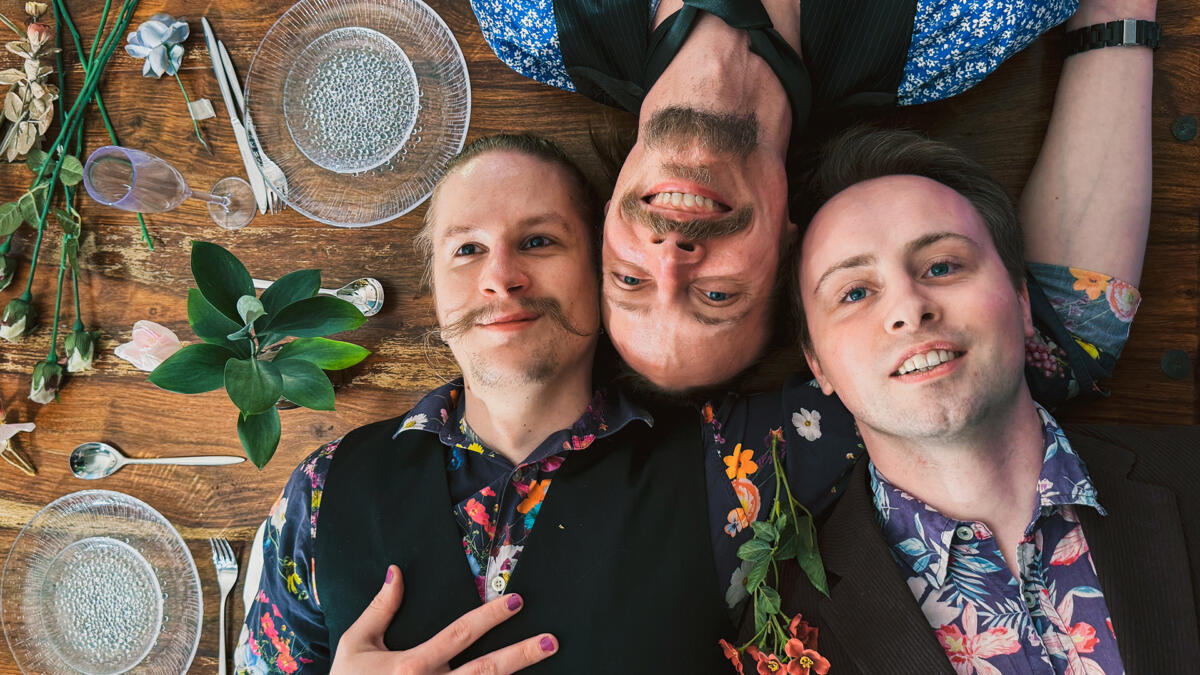Performance Table with No Seating brings on stage the neurodivergent experience
The creators of the performance discuss its origins, research background and pedagogical viewpoints.

Table with No Seating, a performance piece that deals with neurodivergency by three Uniarts Helsinki dance pedagogy students, had its premiere at the Oulu Theatre on 15 August. The multidisciplinary piece by Juho Sarno, Francis Maskens and Timo Filip Salonen handles the everyday challenges of neurodivergent people in a humorous and warm way. The performance combines theatre, circus and dance and offers audiences of all ages an experiece where the unwritten rules of social situations are examined around a dinner table.
1. Could you tell me a little about the background of the piece? How was Table with No Seating born?
During our studies, we found that we’d like to work together and began working on the concept of the performance. Two thirds of our working group are neurodivergent so the topic felt natural and important. At the same time, the variety of our practices and backgrounds became a natural part of the theme.
2. What has collaboration within your group proven to be like?
Although we studied together, we had no prior experience of working together. We also come from different backgrounds, which made it interesting to observe the development of our collaborations and methods.
There are a lot of commonly internalised processes and norms of how performances are made that are easily taken for granted. For us, this process has been and opportunity to develop a method of working that allows all of us to create a performance in a way that, for once, feels suitable for each, without fear of judgement or stress. The method has become unique, perfect for us and at the same time, the performance is exceptional both because it handles neurodivergency and because it’s been created based on neurodivergent experiences.
3. What challenges have you encountared in preparing the performance?
We haven’t faced that many challenges, besides the usual ones. Oulu Theatre welcomed us to their Moninaisuuden näyttämö (“Stage of Diversity”) and has offered practical and production support. We’re grateful for their support and marketing. Furthermore, Nietos ry and the Oulu parkour academy have helped us with residencies, but financial support we haven’t received yet. In other words, we’ve had other jobs on the side of the project which has caused some scheduling issues.
Oh the other hand, the lack of resources has proven to be a blessing for the performance, since it’s given us a chance to take full control of the project exactly how we wanted to and work on solutions that feel just right for us.
4. The background research for the performance included collecting written source material and interviews of neurodivergent people. How did this work affect the content and artistic choices of the performance?
The theoretical research proved to be surprisingly challenging, not because there were not enough sources, but on the contrary because the research on the topic is so robust. Early on we noticed that the spectrum of neurodivergence is hugely varied and the experiences of each individual are first and foremost personal. The interviews were carried out with people close to us, since the topic is sensitive and we wanted to be as natual and honest as possible.
The interviews and becoming familiar with the topic form a starting point from which we began working on the point of view and scenes of the performance. Our own personal experiences became a part of this work during the creative process.
5. How have you striven to take into account the needs of neurodivergent audiences? What kinds of choices have you made to make the performance more accessible?
Our approach to the subject is light, but at the same time we take it seriously and try to avoid smoothing over any wrinkles. Naturally, the scenes do not contain loud sounds or flashing lights. First and foremost, we strive to welcome the audience just as they are. We try to undo norms related to theatre, especially ones related to what is considered proper behavious.
In the beginning, we welcome the audience personally, answer questions and help everyone get to their seats. We verbalise to everyone that it is OK to leave during the performance, or to move around in your chair and ask questions from or share thoughts with the person sitting next to you. For anyone that wants them, we give out ear plugs and stuffed toys to hug. In our premiere audience there was a delightful number of older audiences with Teddy bears!
The performance is also made to be light and easily adapted to different surroundings. We’re not reliant on a black box or theatre tech, rather we can perform the peace wherever the audience is.
6. You’re current and former students of the dance pedagogy programme of the Theatre Academy. Has working on this project offered any pedagogical insights to accessibility in arts education?
Studying dance pedagogy has above all affected the way we view creating the performance as a pedagogical process. That we have, as a working group, managed to create an atmosphere, in which each can work their own way and thrive, has proven to be rather fruitful with other pedagogical situations in mind as well.
7. What do you hope that audiences, both those that share neurodivergent experiences and those that don’t, take away from the performance?
We don’t differentiate between neurodivergent and neurotypical audiences – for us, the audience is, above all, people. Those who have personal experience of neurodivergence can hopefully find the performance relatable and supportive. Regardless of whether an audience member is neurodivergent or not, we hope that they take with them a broader understanding of how we can experience the world and how all of these experiences are valuable in their own way.